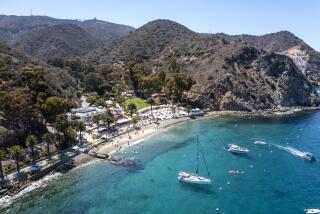Romance of Caribbean
- Share via
MARTINIQUE, French West Indies — Had enough of those impersonal, multistory hotels on your holiday getaways? If so, and if you’re coming here, contact the Martinique Tourist Office. It publishes a guide to smaller hotels as part of what they call the “Relais Creoles.”
Many of the small Relais, or stopover inns, are family owned. Some may be fairly large, but all have been chosen for their charm. A visitor feels comfortable striking up conversations with other guests or locals who happen by for drinks or dinner. Most of the Relais inns in the smaller villages outside of Fort de France, the administrative capital, are on beautiful beachfronts ($45-$100 double).
A year-round water temperature of 78 degrees invites moonlight swims, tempting even the most water-shy to put on mask, fins and snorkel to view the beautiful life on rocks and ledges.
For the beginner wishing to learn how to scuba, dive clubs such as Dominique Tempie’s Tropicasub at the Hotel Casino La Bateliere offer free pool lessons. For the experienced diver the clubs offer escorted tours of nearby reefs. Advanced divers with a yen for history will drive to St. Pierre toward the north of the island. There Mt. Pelee erupted in 1902, spilling volcanic ash over the city and annihilating its 30,000 inhabitants in seconds.
Explorer of Sunken Ships
Every serious diver will look up St. Pierre’s Michel Metery at the Carib Scuba Club. The author of a book about the volcanic eruption and consequent maritime disaster, Metery has explored the many ships that sank when the disaster struck.
Things are quite informal and easygoing. Michel and his club’s instructor, Jacky Imbert, take divers to explore the remnants of 13 ships sunk in St. Pierre Bay. Non-divers are often welcomed aboard the dive boat at no charge, space available, and most often the cordial invitation leads to new friendships and information shared about hikes up to Mt. Pelee and among the ruins of St. Pierre, still preserved, excavated after the eruption.
A small museum at St. Pierre provides a history of the volcano, with artifacts recovered from the ruins. St. Pierre is the 20th Century’s Pompeii.
Farther north the fishing town of Precheur offers tourists a view of Martinique’s Marins Precheurs , the fishermen who cast their nets offshore. If a visitor is lucky he may share a meal of small mackerel rolled in flour and fried in oil with a wonderful crispy taste. The entree is usually a fish soup, called a blaff, made with the catch of the day, spiced, and, for the seafood fancier, tasting as a fisherman’s meal might taste: hot, filling, a delicious way to share the fraternity of a welcoming people.
A short drive north from Precheur along the seacoast or a few minutes by boat, a rental easily arranged with any fisherman, takes one to the offshore rock island of La Perle. Pearl Island offers one of the most beautiful underwater areas in the world. Shallow submerged rocks teem with life for snorkelers, and magnificent gorgonian sea fans provide a backdrop for divers and underwater photographers.
No visit to Martinque is complete without a trip to the Atlantic Ocean coast and its magnificent deserted beaches and stunning cliffs. The water is rougher on the Atlantic coast, but tranquil bays and protected coves abound along the tongue of land that extends from the village of Havre de la Trinite, called Pointe de la Caravelle.
Continuing south along the Atlantic coast, one comes to the fishing village of Vauclin. It is a photographer’s dream. Fishing nets are hung to dry in sheds and brightly painted boats are pulled up on the beach. Not far away, women sell fish and fruits at the street market facing the water.
Historic Diamond Rock
On the way to Diamant is a stunning cliff-side view of the historic rock that was captured, fortified and occupied from 1803 to 1805 by the British during the Napoleonic Wars with France. The 525-foot-high rock was named H.M.S. Diamond Rock by the English blockaders.
Swimmers on the sprawling beaches at Grande Anse du Diamant will feel a wonderful Robinson Crusoe sensation, as if lost in a world left to the adventurous to discover.
To really enjoy creole cooking, a visit to Le Calalou on the beach off the road from Diamant at Anse-a-l’Ane is a treat. Those poking around the waterfront in Fort de France, seeking classical French cuisine, can be assured of good food at the Crew restaurant.
Exploring Martinique is a tantalizing adventure that invites discovery. The magic of creole cooking and hospitality seasoned with a visit to a little piece of France in the sunshine, will leave a stunning memory.
The key to enjoying a Martinique holiday is preparation. Write in advance for free brochures and information. Plan time to discover surprises that await in small coastal villages and along trails that wind through tropical forests.
French West Indies Tourist Board, 610 Fifth Ave., New York 10020. Martinique Tourist Office, B.P. 520, 97206 Fort-de-France, Martinique, F.W.I.
More to Read
Sign up for The Wild
We’ll help you find the best places to hike, bike and run, as well as the perfect silent spots for meditation and yoga.
You may occasionally receive promotional content from the Los Angeles Times.





